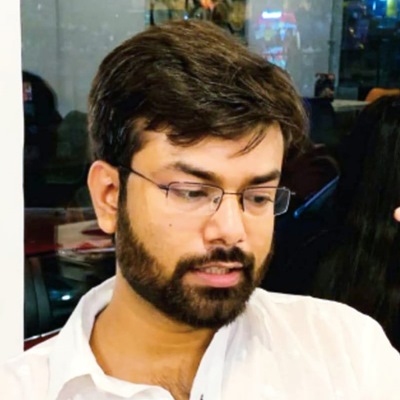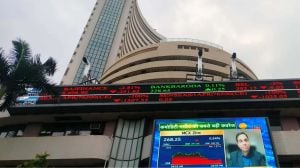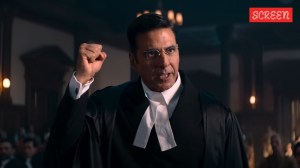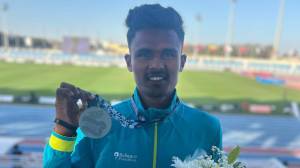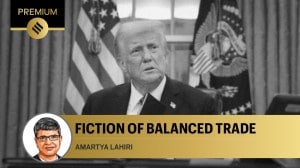UPSC Weekly Current Affairs Quiz | April 06 to April 12, 2025
Brush up your current affairs knowledge with this week's top 15 questions and consolidate your UPSC-CSE preparation. Find answers along with explanations.
 Brush up your current affairs knowledge with this week's top 15 questions. Find a question on the dire wolves in today's quiz. (Colossal Biosciences via AP)
Brush up your current affairs knowledge with this week's top 15 questions. Find a question on the dire wolves in today's quiz. (Colossal Biosciences via AP)UPSC Weekly Quiz is a current affairs-based quiz on relevant topics from the past week, curated for the aspirants of competitive examinations. Attempt the weekly quiz every Saturday and find answers to the MCQs with explanations.
🚨 Click Here to read the UPSC Essentials magazine for March 2025. Share your views and suggestions in the comment box or at manas.srivastava@indianexpress.com🚨
QUESTION 1
With reference to the Panchayat Advancement Index, consider the following statements:
1. It is a multi-dimensional index used to assess the implementation of Localisation of Sustainable Development Goals (LSDGs).
2. It covers all panchayats across India.
3. NITI Aayog releases the index.
How many of the statements given above are correct?
(a) Only one
(b) Only two
(c) All three
(d) None
Explanation
— The government published its inaugural Panchayat Advancement Index (PAI), which ranks over 2.16 lakh panchayats based on their performance and progress towards achieving the Sustainable Development Goals (SDGs).
— The Panchayati Raj Ministry has launched the Panchayat Advancement Index (PAI). It is a multidimensional indicator that evaluates the Localisation of Sustainable Development Goals (LSDGs) across nine main areas. Hence, statement 1 is correct and statement 3 is not correct.
— These include poverty-free and improved livelihoods in panchayats, healthy panchayats, child-friendly panchayats, water-sufficient panchayats, clean and green panchayats, panchayats with self-sufficient infrastructure, panchayats with good governance, and panchayats that are friendly to women. Under these brackets, 144 targets were evaluated.
— The panchayats were then assessed on a scale of 0 to 100 based on these characteristics and classified into five categories: Achiever (90-100), Front Runner (75-90), Performer (60-75), Aspirant (40-60), and Beginner (below 40).
— The PAI does not cover every panchayat. There are about 2.55 lakh panchayats in India, but data was only collected from 2.16 lakh gram panchayats in 29 states/Union Territories after proper certification by the governments and UTs. Hence, statement 2 is not correct.
Therefore, option (a) is the correct answer.
QUESTION 2
The term ‘out turn ratio’ (OTR) refers to:
(a) indicates a significant role of the stock market in the economy.
(b) a measure of the efficiency of the rice milling process.
(c) a measure used in chemistry and biology to describe the concentration of a solution relative to the original.
(d) a measure which assesses the company’s ability to cover its immediate liabilities using its liquid assets.
Explanation
— The Punjab government has banned the selling of hybrid paddy seeds (non-Basmati rice), citing their high price in the state. The government has also stated that these seeds result in a larger percentage of broken rice during milling — the process of removing the outer husk and bran layers from paddy (unmilled rice) to produce edible, white rice — when compared to Food Corporation of India (FCI) guidelines.
— There are about eight hybrid paddy types that are officially recommended for planting in Punjab. Savannah, VNR, Corteva, and Bayer are some of the private seed businesses in the state that offer these authorised hybrids. Some of the most popular varieties include Sava 127, Sava 134, Sava 7501, 27P22, VNR 203, and others.
— Farmers say that hybrid cultivars provide substantial advantages over traditional kinds, including as shorter growing cycles and higher yields.
— These hybrid kinds, which have a development period of approximately 125 to 130 days, typically yield between 35 and 40 quintals per acre, outperforming both short- and long-duration varieties now available in the state.
— During the 2024-25 Kharif marketing season, rice millers in Punjab refused to accept hybrid rice types. They are responsible for storing and milling government-procured paddy. These millers claimed that the out turn ratio (OTR) of these kinds, which measures the efficiency of the rice milling process, was lower than that required by the FCI. While the FCI requires a minimum OTR of 67%, the millers indicated that the OTR of hybrid rice varieties ranged between 60% and 63%.
— This shortage requires millers to suffer the financial loss out of their own pockets. As a result, in 2024, the Punjab government had to persuade millers to stockpile these types despite strong opposition. However, to avert such a catastrophe, the government has prohibited the selling of hybrid paddy seeds prior to the start of the sowing season.
Therefore, option (b) is the correct answer.
QUESTION 3
With reference to the Mahatma Gandhi National Rural Employment Guarantee Act (MNREGA), consider the following statements:
1. It is the largest employment guarantee programme in the world.
2. The Ministry of Home Affairs implements NREGA.
3. The wages are the same throughout all the states in India.
Which of the statements given above is/are correct?
(a) 1 and 2 only
(b) 1 only
(c) 3 only
(d) 2 and 3 only
Explanation
— The Parliamentary Standing Committee on Rural Development and Panchayati Raj presented its report on the Mahatma Gandhi National Rural Employment Guarantee Act (NREGA).
— With more than 25 crore registered workers, NREGA is the world’s largest job guarantee initiative. It provides up to 100 days of work each year to rural households. Hence, statement 1 is correct.
— The Ministry of Rural Development (MoRD), which implements NREGA, announced the state-specific daily salary rates for Fiscal Year (FY) 25-26 in the final week of March. These range from Rs 241 in Nagaland to Rs 400 in Haryana, with the national average wage at Rs 294, a modest 5% gain over FY 24-25. Hence, statements 2 and 3 are not correct.
— Section 6 of the Act provides two methods for calculating NREGA wage rates.
— Section 6(1) empowers the Centre to notify the wage rate notwithstanding the Minimum Wages Act, 1948 (MWA). The notified wage, however, cannot be lower than Rs 60.
— Section 6(2) states that until the Centre notifies a wage rate, the state’s minimum agricultural wage rate shall be taken as the NREGA wage rate.
Therefore, option (b) is the correct answer.
QUESTION 4
With reference to the Kavach, consider the following statements:
1. It aids the Loco Pilot in running of trains within specified speed limits by automatic application of brakes in case Loco Pilot fails to do so.
2. Kavach 5.0 is the latest in the series of Automatic Train Protection (ATP) systems which will be implemented to increase the number of trains by 30 percent.
Which of the statements given above is/are correct?
(a) 1 only
(b) 2 only
(c) Both 1 and 2
(d) Neither 1 nor 2
Explanation
— Union Minister for Railways Ashwini Vaishnaw declared that Kavach 5.0, the latest in the series of Automatic Train Protection (ATP) systems, will be installed to boost the number of trains in Mumbai’s suburbs by 30%. Currently, Kavach 4.0 is being implemented in various regions of Indian Railways. Hence, statement 2 is correct.
— Kavach assists the Loco Pilot in keeping trains within set speed limits by automatically applying brakes if the Loco Pilot fails to do so, as well as ensuring that trains run safely during inclement weather. Hence, statement 1 is correct.
— Kavach 5.0 is currently being developed with a specific goal in mind for Mumbai. The development will be completed by the end of December. This indicates that if we can shorten the 180-second gap between two trains by 30%, we will be able to operate 30% additional trains.
— Automatic Train Protection (ATP) is a train safety technology that ensures a train’s speed stays within the limitations defined by the signalling system. It continuously monitors the train’s speed and automatically enforces the permissible speed limits. If the train exceeds the permissible speed or fails to respond to specified signal characteristics, ATP immediately activates the emergency brakes, bringing the train to a stop.
Therefore, option (c) is the correct answer.
QUESTION 5
With reference to the germline sequence, consider the following statements:
1. It is the nucleotide sequence that a person was conceived and born with.
2. They are obtained from red blood cells.
3. It can explain an individual’s predisposition towards certain diseases or disorders.
How many of the statements given above are correct?
(a) Only one
(b) Only two
(c) All three
(d) None
Explanation
— The first phase of India’s ambitious effort to map its people’s genetic variety has been completed, and the data are available for use. The Genome India Project (GIP) has collected the whole gene sequences of 10,000 people from 83 ethnic groupings.
— Scientists use projects like GIP to gather and archive germline sequences, which are the nucleotide sequences that a person was born with. Over time, a person’s DNA sequence evolves, with each cycle of cell division introducing a few additional variants, or mutations. Hence, statement 1 is correct.
— Germline sequences are derived from white blood cells, which are better at retaining the original sequence during cell division. Hence, statement 2 is not correct.
— Among other things, the unique components of this germline sequence may provide information about an individual’s proclivity for specific diseases or disorders. It can explain not just why a specific person has a problem, but also why certain treatment options may be ineffective in this circumstance. This could pave the way for the development of personalised medicine, in which a patient receives a tailored remedy to their ailment or disorder rather than a generic medication. Hence, statement 3 is correct.
Therefore, option (b) is the correct answer.
QUESTION 6
With reference to the dire wolf, consider the following statements:
1. It was the largest of the Late Pleistocene canids of North America.
2. Recently, Colossal Biosciences has successfully used gene-editing techniques to create exact replicas of the wolf that resemble the extinct species.
3. The first dire wolf fossils were found in 1854 from the Ohio River
Which of the statements given above is/are correct?
(a) 2 only
(b) 1 only
(c) 1 and 3 only
(d) 2 and 3 only
Explanation
— Much of what we know about the dire wolf is derived from fossil-rich sites such as the La Brea Tar Pits in Los Angeles. These natural traps saved thousands of animals, including almost 4,000 dire wolf specimens. Clearly, they once thrived in a variety of habitats.
— That genetic isolation may have contributed to their downfall. As the Ice Age ended, the environment shifted, food sources diminished, and new predators appeared. The dire wolf, which had evolved to kill massive herbivores that were now extinct, was unable to keep up.
— In a twist worthy of science fiction, efforts are underway to resurrect portions of the dire wolf. Colossal Biosciences, a biotech business, has successfully employed gene-editing techniques to make wolf hybrids that look like the extinct species. These creatures, named Remus, Romulus, and Khaleesi, were born with some of the size and characteristics associated with the dire wolf, such as dense fur and a robust build.
— They’re not exact replicas, but they represent a step toward understanding and potentially reviving some characteristics of extinct species. Hence, statement 2 is not correct.
— The dire wolf was North America’s largest late Pleistocene canid. Hence, statement 1 is correct.
— The first dire wolf fossils were discovered in 1854 along the Ohio River in Indiana. Hence, statement 3 is correct.
Therefore, option (c) is the correct answer.
QUESTION 7
Which of the following Space Agencies have launched a new mission, the Biomass mission, which will map the world’s forests?
(a) National Aeronautics and Space Administration
(b) Indian Space Research Organisation
(c) European Space Agency
(d) Japan Aerospace Exploration Agency
Explanation
— The European Space Agency’s (ESA) new mission to survey the world’s forests will launch later this month. The Biomass mission will give information about the state of the planet’s forests and how they are changing, thereby expanding our understanding of the significance of forests in the carbon cycle.
— Biomass is ESA’s seventh Earth Explorer mission. The space agency launched satellites as part of the Earth Explorer programme to observe various parts of the planet’s system.
— The project will also enable scientists to better measure how carbon levels are changing as humans continue to cut down forests and increase CO2 levels in the atmosphere.
Therefore, option (c) is the correct answer.
QUESTION 8
With reference to the India-Middle East-Europe Economic Corridor (IMEC), consider the following statements:
1. The project is an outcome of the growing diplomatic and political convergence between India, the Gulf countries, Israel, the United States (US) and the European Union (EU).
2. It seeks to develop a seamless infrastructure of ports, railways, roads, sea lines and pipelines to enhance trade.
3. The Memorandum of Understanding (MoU) for the IMEC was signed in 2024 during the G-20 summit.
How many of the statements given above are correct?
(a) Only one
(b) Only two
(c) All three
(d) None
Explanation
— Jaishankar believes that the proposed India-Middle East-Europe Economic Corridor (IMEC) will provide a “truly new global axis” for economies, energy resources, and communications.
— The India-Middle East-Europe Economic Corridor (IMEC) is a connectivity project that aims to create a seamless network of ports, railroads, roads, sea lines, and pipelines to boost trade between India, the Arabian Peninsula, the Mediterranean region, and Europe. Hence, statement 2 is correct.
— The IMEC aspires to capitalise on existing commercial routes between India and the Arab Gulf, as well as the Eastern Mediterranean and Europe, and to create the infrastructure required to connect the Gulf and Mediterranean areas.
— The project is the result of growing diplomatic and political convergence among India, the Arab Gulf countries, Israel, the United States (US), and the European Union (EU), all of whom agree on the importance of improving sea and land connectivity in order to increase economic exchanges between these regions. Hence, statement 1 is correct.
— The IMEC Memorandum of Understanding (MoU) was signed in September 2023 in New Delhi during the G-20 summit by India, Saudi Arabia, the United Arab Emirates (UAE), France, Germany, Italy, the United States, and the European Union. Hence, statement 3 is not correct.
Therefore, option (b) is the correct answer.
QUESTION 9
With reference to the Sundials and clock towers, consider the following statements:
1. It tells time using shadows cast by the Sun.
2. These are the oldest human-made timekeeping devices.
3. Clock towers were erected across northern India in the years following the Revolt of 1857 to serve as reminders of the “supremacy of the Raj”.
Which of the statements given above are correct?
(a) 1 and 2 only
(b) 2 and 3 only
(c) 1 and 3 only
(d) 1, 2 and 3
Explanation
— Sundials, which tell time using shadows cast by the Sun, are among the oldest human-made timekeeping devices. The Greek historian Herodotus (c. 484-425 BCE) attributed its development to the ancient Babylonians; nevertheless, several civilisations are believed to have built their own sundials at various points in history. Hence, statements 1 and 2 are correct.
— The Industrial Revolution, which began in England in the middle of the 18th century, radically altered humans’ relationship with time. The rise of the modern industrial and wage work required not only keeping time, but also making the most of it.
— Clock towers were comparable to medieval bell towers, but they included one or more clock faces. To tell the time, one merely had to glance up, rather than wait for the bell to toll (though clock towers continued to ring bells at specific times of day).
— According to historian Thomas R Metcalf, clock towers were erected across northern India in the years following the 1857 Revolt to serve as reminders of the “supremacy of the Raj”. Hence, statement 3 is correct.
Therefore, option (d) is the correct answer.
QUESTION 10
With reference to the F-1 visa-holders, consider the following statements:
1. They enjoy the same constitutional protections and rights as American citizens.
2. Students in the US on an F-1 visa are allowed to work off-campus in their first academic year.
3. The visa can be suspended or revoked if immigration officials determine that students are not complying with visa rules.
How many of the statements given above are correct?
(a) Only one
(b) Only two
(c) All three
(d) None
Explanation
— F-1 visa holders often have the same constitutional protections and privileges as American citizens, according to Joshua Bardavid, a New York-based immigration lawyer who talked with The New York Times. Hence, statement 1 is correct.
— However, if immigration officials believe that students are not following visa restrictions, the visa may be suspended or withdrawn. According to the New York Times, US Secretary of State Marco Rubio’s decision to review visa applicants’ social media postings could result in students being denied entry if they insult the US or Israel. Hence, statement 3 is correct.
— Students in the United States on an F-1 visa are not permitted to work off-campus during their first school year. After the first year, individuals can participate in either Curricular Practical Training (CPT), which allows them to get subject-related experience while enrolled in an academic degree, or Optional Practical Training (OPT), which they commonly undertake after completing their program. Hence, statement 2 is not correct.
— They must also demonstrate that they can afford to live in the United States for the duration of their studies by displaying sufficient funds in the bank.
Therefore, option (b) is the correct answer.
QUESTION 11
Recently, an original painting from the 1600s, Mary Magdalene in Ecstasy, was unveiled at Delhi’s Italian Cultural Centre. Which famous artist created this work?
(a) Leonardo da Vinci
(b) Michelangelo Merisi da Caravaggio
(c) Giovanni Bellini
(d) Raphael
Explanation
— Italian Baroque artist Michelangelo Merisi da Caravaggio’s original painting, ‘Mary Magdalene in Ecstasy’, was unveiled at Delhi’s Italian Cultural Centre from April 11 onwards, and later at the Kiran Nadar Museum of Arts this month.
— With origins in the Bible, Mary Magdalene was imagined as a repenting sinner who became a follower of Jesus Christ, and exiled herself to a cave in France after his death. This was an important figure, who had witnessed both the crucifixion and resurrection of Christ. As the official website for Caravaggio’s works puts it, Magdalene in her solitude “was transported by angels seven times a day into Heaven where ‘she heard, with her bodily ears, the delightful harmonies of the celestial choirs’.”
— So when Caravaggio broke away from the tradition of depicting her as a grand levitating figure among angels in Heaven, it turned heads. He painted her alone in a portrait, with dramatically enhanced facial features in a pitch-dark room, her ear exposed, her arms clasped, her eyes and lips half open, looking above.
Therefore, option (b) is the correct answer.
QUESTION 12
US President Donald Trump’s unilateral tariff impositions are comparable, for the scale of shocks unleashed and transformation engendered to the international trading or monetary system, to other actions seen in history. In 1971, the then US President unilaterally ordered the “suspension” of the convertibility of the dollar into gold. With foreign governments and central banks no longer able to exchange their dollar reserves for gold, it marked the beginning of the end of the Bretton Woods regime. This turning point in global economic history is often referred as:
(a) The Volcker Shock
(b) Wall Street Crash
(c) Great Depression
(d) The Nixon Shock
Explanation
— On August 15, 1971, the then US President Richard Nixon unilaterally — like Trump — ordered the “suspension” of the convertibility of the dollar into gold. With foreign governments and central banks no longer able to exchange their dollar reserves for gold, it marked the beginning of the end of the Bretton Woods regime.
— In December 1971, the dollar was devalued against gold to $38 per ounce. Other leading industrialised countries agreed to revalue (appreciate) their currencies. The net effect was a 10.7% average depreciation of the dollar relative to these currencies. But even this new set of fixed exchange parities vis-à-vis a devalued dollar couldn’t hold. As gold prices, a barometer of uncertainty, soared to $90 an ounce in early 1973, the dollar came under speculative attacks. Towards March 1973, nearly all key currencies were floating against the dollar.
— The Nixon Shock effectively inaugurated the era of unstable floating exchange rates and “fiat” government-issued currencies not backed by gold or any other solid physical asset. The value of any currency and its exchange rate was, henceforth, based on the public’s (including global investors’) faith in its issuing country.
Therefore, option (d) is the correct answer.
QUESTION 13
With reference to Digital Threat Report 2024, consider the following statements:
1. It was released by the Indian Computer Emergency Response Team (CERT-In), the Computer Security Incident Response Team in the Finance sector (CSIRT-Fin), and a global Cybersecurity company.
2. This report focuses on the Banking, Financial Services, and Insurance (BFSI) sector.
3. It states that while threat actors initially used Bitcoin for illicit transactions, they have since migrated to other cryptocurrencies like Monero (XMR).
Which of the statements given above is/are true?
(a) 1 only
(b) 1 and 3 only
(c) 2 and 3 only
(d) 1, 2 and 3
Explanation
— Recently, the Digital Threat Report 2024 for the Banking, Financial Services, and Insurance (BFSI) sector was released by the Indian Computer Emergency Response Team (CERT-In), the Computer Security Incident Response Team in the Finance sector (CSIRT-Fin), and SISA, a global Cybersecurity company. The report has flagged cryptocurrency as a new frontier for cyber threats. It states that while threat actors initially used Bitcoin for illicit transactions, they have since migrated to other cryptocurrencies like Monero (XMR).
Therefore, option (d) is the correct answer.
QUESTION 14
One of the features of Article 201 that has caused differences in Centre-State relations over the years is the absence of a time limit within which the President is required to declare the grant or withholding of assent once a Bill is reserved for his/her consideration by the Governor.
The X Commission had pointed this out and recommended that definite timelines be adopted to facilitate the efficient disposal of references under Article 201.
“X” in these lines refers to:
(a) Nanavati Commission
(b) Kalelkar Commission
(c) Thakkar Commission
(d) Sarkaria Commission
Explanation
— In setting timelines for Governors to act on Bills presented to them by the state legislatures, the Supreme Court has, for the first time, prescribed that the President should take a decision on the Bills reserved for consideration by the Governor within a period of three months from the date on which such reference is received.
— It said “in case of any delay beyond this period, appropriate reasons would have to be recorded and conveyed” to the state concerned.
— Calling for a decision within three months is significant because under Article 201 of the Constitution no timeframe has been set for a Presidential decision.
— It said the Sarkaria Commission had pointed to this and “recommended that definite timelines must be adopted for facilitating the efficient disposal of references under Article 201” and that “the reading of a timeline in Article 201 was also suggested by the Punchhi Commission”.
— The Sarkaria Commission, headed by former Supreme Court judge Justice R S Sarkaria, was set up in 1983 to review the working of the existing arrangements between the Union and the States. The Punchhi Commission too was on Centre- State relations and was set up in 2007 under former Chief Justice of India Justice M M Punchhi.
Therefore, option (d) is the correct answer.
QUESTION 15
Recently, Tahawwur Hussain Rana arrived in Delhi on Thursday (April 10) following his extradition from the United States. He is a key conspirator of the:
(a) 2019 Pulwama attack
(b) 2008 Mumbai attacks
(c) 2005 Delhi bombings
(d) 2001 Indian Parliament attack
Explanation
— Tahawwur Hussain Rana, a key conspirator of the 26/11 terrorist attacks in Mumbai, arrived in Delhi on Thursday (April 10) following his extradition from the United States.
— The arrival of Rana, who was arrested in Chicago in 2009, the year after the terror attacks in which 166 people were killed, marks the culmination of a prolonged legal process. He will be prosecuted by the National Investigation Agency (NIA) on charges of terrorism for 2008 Mumbai attacks.
— Other key 26/11 figures such as Hafiz Saeed, the founder of the Lashkar-e-Taiba, Major Iqbal, the shadowy ISI handler of the terrorists, and the terrorists’ trainer Sajid Majid alias Sajid Mir remain in Pakistan.
Therefore, option (b) is the correct answer.
Previous Weekly Quiz
UPSC Weekly Current Affairs Quiz | March 30 to April 05, 2025
UPSC Weekly Current Affairs Quiz | March 23 to March 29, 2025
UPSC Weekly Current Affairs Quiz | March 16 to March 22, 2025
UPSC Weekly Current Affairs Quiz | March 09 to March 15, 2025
UPSC Weekly Current Affairs Quiz | March 02 to March 08, 2025
Subscribe to our UPSC newsletter and stay updated with the news cues from the past week.
Stay updated with the latest UPSC articles by joining our Telegram channel – IndianExpress UPSC Hub, and follow us on Instagram and X.
Must Read
Buzzing Now
Apr 17: Latest News
- 01
- 02
- 03
- 04
- 05

